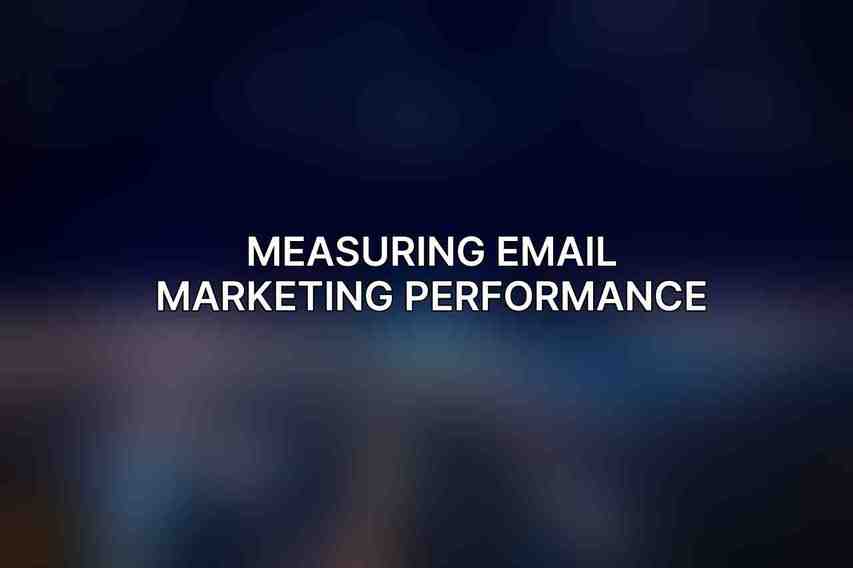Email marketing analytics play a pivotal role in the success of any email marketing campaign. By analyzing data and statistics related to email interactions, marketers can gain valuable insights into their audience’s behavior, preferences, and engagement levels. Leveraging email marketing analytics allows businesses to make data-driven decisions, enhance campaign performance, and ultimately achieve higher conversion rates.
The benefits of utilizing email analytics are multifold. It enables marketers to track and measure the effectiveness of their email campaigns, understand subscriber behavior, personalize content for better engagement, segment audiences effectively, optimize email delivery timings, and improve overall Return on Investment (ROI) through targeted marketing efforts.
Measuring Email Marketing Performance

A. Open Rates
Definition: The open rate is the percentage of recipients who open an email. It gives insights into the effectiveness of subject lines, send times, and the overall attractiveness of the email content.
Industry Benchmarks: Industry benchmarks for open rates vary across different sectors and can serve as a point of reference for campaign performance evaluation.
Factors Influencing Open Rates: Factors like subject line quality, sender reputation, email design, and mobile optimization significantly impact open rates. Read more about this on How Analytics Transform Social Media Marketing Strategies
B. Click-Through Rates (CTRs)
Definition: CTRs measure the percentage of recipients who clicked on links within an email. It indicates the engagement level and relevance of the email content to the audience.
Importance of CTRs: CTRs help assess the effectiveness of the call-to-action (CTA) and the overall engagement level of the email campaign.
Tactics to Improve CTRs: Personalizing content, optimizing CTAs, segmentation, A/B testing, and providing valuable offers are strategies to enhance CTRs.
C. Conversion Rates
Such as making a purchase or filling out a form. Check this blog on Boost Your Online Performance: Conversion Rate Optimization and Analytics
Measuring Conversion Rates: Tracking conversions helps in understanding campaign success and analyzing the impact of email marketing efforts on business goals.
Optimizing for Conversions: Improving landing pages, simplifying the conversion process, and personalizing offers can enhance conversion rates.
Key Email Marketing Metrics

A. Bounce Rates
Types of Bounce Rates: Bounce rates are classified as either soft bounces (temporary issues) or hard bounces (permanent issues) and indicate email deliverability challenges.
Understanding the Impact of Bounces: High bounce rates can harm sender reputation, affect deliverability, and reduce overall campaign effectiveness. Dive deeper into Best Tools for Digital Marketing Analytics 2024
Strategies to Reduce Bounce Rates: Maintaining clean email lists, implementing double opt-ins, and verifying email addresses can mitigate bounce rates.
B. Deliverability Rates
Importance of Deliverability: Deliverability rates measure the ability of emails to reach recipients’ inboxes successfully, impacting the overall campaign performance.
Factors Affecting Deliverability: Spam complaints, sender authentication, engagement levels, content quality, and email relevance influence deliverability rates.
Best Practices for Enhancing Deliverability: Adopting email authentication protocols, segmenting subscribers, monitoring sender reputation, and avoiding spam triggers can improve deliverability.
C. List Growth Rate
Definition: The list growth rate signifies the speed at which an email list is expanding, reflecting subscriber acquisition and retention efforts.
Importance of List Growth: A growing email list enhances reach, engagement, and conversion opportunities for email campaigns.
Techniques to Increase List Size: Implementing sign-up forms, incentivizing subscriptions, running promotions, and creating valuable content can boost list growth rates.
D. Return on Investment (ROI)
Calculating Email Marketing ROI: ROI calculation involves analyzing campaign costs, revenue generated, and attributing conversions to email marketing efforts.
Factors Contributing to ROI: Factors like conversion rates, average order value, campaign costs, and customer lifetime value influence email marketing ROI.
Maximizing ROI: Personalizing content, segmenting audiences, optimizing send times, and improving email deliverability can maximize email marketing ROI.
Advanced Email Analytics
A. Cohort Analysis
Definition: Cohort analysis groups users based on shared characteristics to analyze their behavior and engagement patterns over time.
Value in Email Marketing: Cohort analysis helps identify trends, assess customer lifetime value, personalize campaigns, and improve retention strategies.
Cohort Analysis Techniques: Segmenting cohorts based on time, behavior, or demographics, and analyzing retention rates and engagement metrics are common techniques.
B. Segmentation Analysis
Importance of Segmentation: Segmentation divides subscribers into targeted groups based on characteristics, preferences, or behaviors to deliver personalized and relevant content.
Types of Segmentation: Behavioral, demographic, geographic, psychographic segmentation, and RFM (Recency, Frequency, Monetary) analysis are common segmentation types.
Advanced Segmentation Strategies: Dynamic content, predictive segmentation, lifecycle stages, and machine learning algorithms enhance segmentation precision and effectiveness.
C. Multivariate Testing (MVT)
Concept of MVT: Multivariate testing involves testing multiple elements simultaneously to determine which combination yields the best performance.
Benefits of MVT in Email: MVT helps optimize email content, layouts, CTAs, and personalization for increased engagement and conversion rates.
Conducting MVT Campaigns: A/B testing variations, analyzing results, segmenting test audiences, and implementing winning variations are steps in conducting MVT campaigns.
Tools for Email Marketing Analytics
A. Google Analytics for Email Marketing
B. Mailchimp’s Email Analytics Platform
C. Litmus Email Analytics Suite
D. Email Analytics Features in Marketing Automation Platforms
Best Practices for Email Marketing Analytics
A. Establishing Clear Goals and Metrics
B. Tracking Key Performance Indicators (KPIs)
C. Monitoring Analytics Regularly
D. Interpreting Data and Making Informed Decisions
E. Continuously Optimizing Email Campaigns
mastering email marketing analytics is essential for optimizing campaign performance, understanding audience behavior, and driving successful outcomes. By focusing on key metrics, leveraging advanced analytics techniques, utilizing appropriate tools, and following best practices, marketers can enhance their email marketing strategies and achieve remarkable results in the ever-evolving digital world. Dive deeper into SEO Analytics: Tracking and Improving Your Online Visibility
Frequently Asked Questions
What are email marketing analytics?
Email marketing analytics refer to the data and metrics related to the performance of your email marketing campaigns. This includes metrics such as open rates, click-through rates, conversion rates, and more.
Why are email marketing analytics important?
Email marketing analytics are important because they provide valuable insights into the effectiveness of your email campaigns. By analyzing this data, you can identify what is working well and what can be improved, ultimately helping you optimize your email marketing strategy for better results.
What are some key email marketing analytics metrics to track?
Some key email marketing analytics metrics to track include open rates, click-through rates, conversion rates, bounce rates, email deliverability, and ROI (Return on Investment). These metrics can help you gauge the success of your email campaigns and make data-driven decisions to improve performance.
How can I use email marketing analytics to improve my campaigns?
You can use email marketing analytics to improve your campaigns by identifying trends and patterns in your data, testing different variables (such as subject lines, sending times, and content), segmenting your audience based on their behavior, and tracking the impact of your changes over time. By leveraging this data, you can continuously optimize your email marketing strategy for better results.
What tools can help me analyze email marketing analytics?
There are several email marketing analytics tools available that can help you track and analyze your email campaigns, such as Mailchimp, Constant Contact, Sendinblue, and HubSpot. These tools provide features to monitor key metrics, A/B test campaigns, segment your audience, and generate reports to help you make informed decisions for your email marketing efforts.

